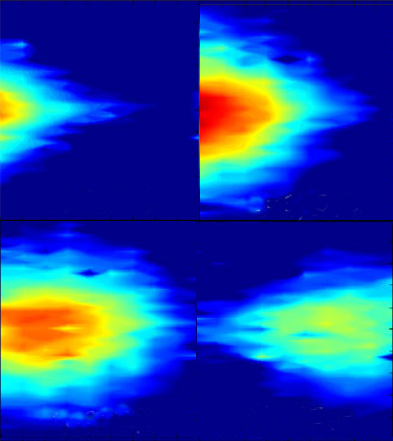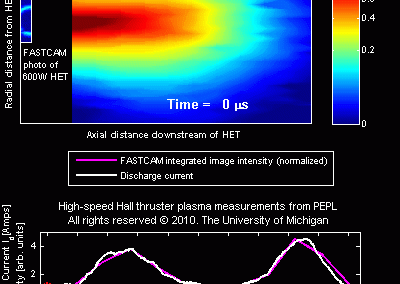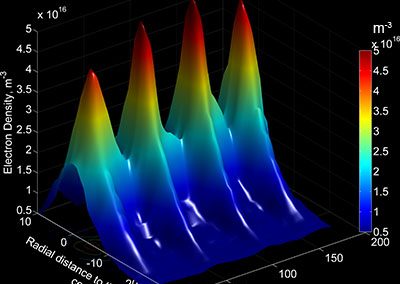Project
High-Speed Thruster and Cathode Plasmadynamics
Plasma density during a breathing cycle, measured with a high-speed Langmuir probe with transfer function data fusion techniques.
project personnel
Zachariah Brown, Parker Roberts
principal investigator
Benjamin Jorns
previous personnel
Ethan Dale, Marcel Georgin, Kimberly Trent, Michael Sekerak, Robert Lobbia, Tom Liu, Mike McDonald, Roland Florenz
project sponsors
AFOSR, AFRL, DoE, NASA
associated thrusters
H6
Arising from the myriad of electromagnetic interactions between excited propellant particles, electrons, and the imposed magnetic and electric fields, HET plasmas (as well as cathodes, ion thrusters, pulsed plasma discharges, etc.) are rich with oscillation in a wide band ranging from 1 kHz to 20 GHz.
The existence of plasma oscillations in the near- and far-field discharge of a Hall effect thruster alters the conventionally held view of their operation as steady electrostatic propulsion devices. Indeed, the consequences from fluctuations in ionized propellant density, temperature, and potential may include increased thrust, exacerbated engine erosion, and spacecraft interference. In this research project, the unsteady nature of a Hall effect thruster discharge has been investigated via two-dimensional, time-resolved plasma measurements. A novel dual Langmuir probe diagnostic (HDLP, see ref. 2) was developed to enable an unprecedented temporal resolution for electrostatically acquired plasma properties near the upper theoretical limits (1-10 MHz, see ref. 3). Observations of large amplitude transient oscillations caused by the Hall thruster breathing mode were seen for all thruster conditions at all spatial locations and in all measured plasma properties including: discharge current, electron density, electron temperature, plasma potential, and visible light emission. A unique method of spatiotemporal data fusion (see ref. 4) facilitates visualization of two-dimensional time-resolved planar plasma density contour maps of discrete turbulent bursts of plasma ejected as the thruster exhales breaths of ionized propellant at velocities in excess of 12 km/s (see fig. 1). An initial time-resolved investigation of the plasma downstream from a Hall thruster unveiled an environment rich in oscillatory behavior dominated by the Hall thruster breathing mode. These insights emphasize the importance of time-resolved plasma measurements and, through enhanced understanding of the discharge process, may ultimately lead to improved thruster designs that work in concert with plasma fluctuations to achieve enhanced performance. (From ref. 1)
The initial 100-kHz HDLP diagnostic developed for this research provided measurements of unprecedented spatial and temporal detail within a HET plume. However, an examination of the temporal limitations of the probe (from ref. 3) suggests that an upper probing rate of 1-10 MHz is possible. Future development of this capability is already underway, and the finer temporal detail (coupled with a faster 1-Mfps high-speed camera) will enable the examination of higher-frequency plasma oscillations such as the azimuthal modes (ionization, transit-time, drift instability, etc.) common in the very-near-field of HETs. To that end, future measurements using this advanced HDLP to perform internal time-resolved measurements would be tremendously insightful, and are thus part of ongoing research. The strong magnetic fields in this region are known to exhibit anomalous electron transport, and with detailed time-resolved measurements, one could examine the nature of turbulent transport. Additionally, the use of a HDLP for obtaining time-resolved electron energy distribution functions was shown to be promising in early work and there is ongoing effort to obtain time-resolved EEDFs at a rate of 1 MHz. Measurements of the unsteady state of electron equilibrium could help identify transient plasma phenomena that could be tailored to enhance the efficiency of ionization and particle acceleration in Hall thrusters and other plasma devices.
Selected Publications
A Time-resolved Investigation of the Hall Thruster Breathing Mode
Lobbia, R. B
Electron Transport in Hall Thrusters
McDonald, M.
Plasma Oscillations and Operational Modes in Hall Effect Thrusters
Sekerak, M.
Time-resolved internal Hall thruster plasma measurements using a high-speed Langmuir probe
Dale, E.T., Gallimore, A.D., and Lobbia, R.B.
Passive High-speed Imaging of Ion Acoustic Turbulence in a Hollow Cathode
Georgin, M.P., Byrne, M.P., Ciaston, N.E., Jorns, B.A., and Gallimore, A.D
Propagation of ion acoustic wave energy in the plume of a high-current LaB6 hollow cathode
Jorns, B.A., Dodson, C., Goebel, D.M., and Wirz, R.
Dispersion relation measurements of plasma modes in the near-field plume of a 9-kW magnetically shielded thruster
Brown, Z. A., and Jorns, B. A.
Ion Acoustic Turbulence in the Hollow Cathode Plume of a Hall Effect Thruster
Cusson, S.E., Brown., Z, Dale, E.T., Jorns, B.A., and Gallimore, A.D.
Spatial Evolution of Plasma Waves in the Near-field of a Magnetically Shielded Hall Thruster
Brown, Z. and Jorns, B.A.
Non-invasive time-resolved measurements of anomalous collision frequency in a Hall thruster
E.T. Dale and B.A. Jorns
Experimental Correlation between Anomalous Electron Collision Frequency and Plasma Turbulence in a Hall Effect Thruster
Brown, Z.A, Dale, E., and Jorns, B.A.
Spatial Evolution of Small Wavelength Fluctuations in a Hall Thruster
Brown, Z.A. and Jorns, B.A.
Non-classical electron transport in the cathode plume of a Hall effect thruster
Benjamin A. Jorns, Sarah E. Cusson, Zachariah Brown, and Ethan Dale
Transient non-classical transport in the hollow cathode plume I: measurements of time-varying electron collision frequency
Georgin, Marcel P; Jorns, Benjamin A. Gallimore, Alec D
Transient non-classical transport in the hollow cathode plume II: evaluation of models for the anomalous collision frequency
Georgin, Marcel P; Jorns, Benjamin A.
Perspectives on Physics of ExB Discharges Relevant to Plasma Propulsion and Similar Technologies
Kaganovich, Igor D. et al
Rotational Waves in the Plume of an Externally-Mounted Hall Thruster Cathode
Shadrach Hepner, Edward Tang, Ethan Dale, and Benjamin A Jorns
Experimental measurements of the contribution of plasma turbulence to anomalous collision frequency in a Hall thruster
Zachariah A. Brown and Benjamin A. Jorns
Experimental characterization of Hall thruster breathing mode dynamics
Ethan T. Dale, Benjamin A. Jorns
Experimental Characterization of Wave-Induced Azimuthal Ion Velocities in a Hollow Cathode Plume
Parker J. Roberts, Benjamin A. Jorns, and Vernon H. Chaplin
Growth and Saturation of the Electron Drift Instability in a Crossed Field Plasma
Zachariah A. Brown and Benjamin A. Jorns
Laser Measurement of Anomalous Electron Diffusion in a Crossed-Field Plasma
Roberts, P.J. and Jorns, B.A.
Hollow cathode electron properties are consistent with marginally stable turbulence
Roberts, P.J., Brown, Z.A., and Jorns, B.A
Characterization of a 10 W class electrospray array thruster
Whittaker, C., Arestie, S., Marrese-Reading, C., and Jorns, B.A



